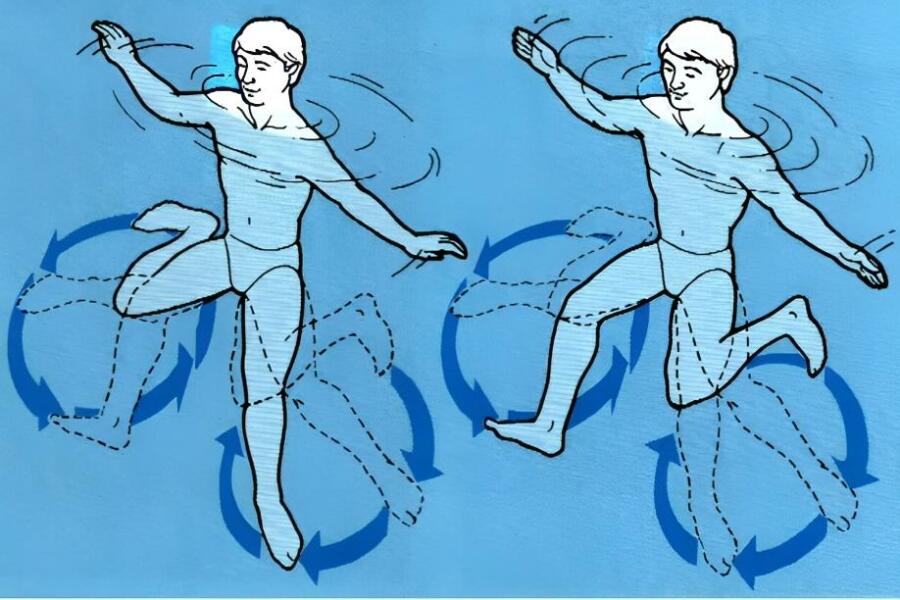Everyone should be able to swim because it can rescue you from dangerous or life-threatening situations. Treading water is a vital life-saving skill. Being able to tread water well is crucial since utilizing the incorrect method can drain a lot of energy, which would be detrimental in a situation where survival is at stake.
What is Treading Water?
One must use both arms and legs to keep afloat while treading water. Since it’s a fundamental survival swimming skill, most people acquire it before learning to swim. The act of treading water is also widely used in aquatic sports like art and water polo, which can help you develop overall body strength and endurance.
The arms and legs move the body in a way that doesn’t move it in any particular direction but merely maintains its buoyancy without requiring much energy. The legs engage in a particular kick known as the “egg-beater” kick to maintain body buoyancy while the arms balance the body in the water. The head must be held above the water while performing vertical water treading.
How to Tread Water Effortlessly

1. Maintain Your Body Straight and Upright
Body position while treading water must be vertical. Having your face at the same level as the water may seem safer when you are in trouble, but doing so increases the likelihood that water will get in your nose, eyes, and mouth.
Gently scull the water with the hands while spreading the arms slightly outward and bending the elbows. The hands make an eight-shaped motion when sculling. The head should remain above the water’s surface, and the spine should remain straight.
2. Control Your Breathing
Keeping control of your breathing and mental state is crucial in an emergency. Take a few deep breaths to calm down and relax the body and mind. Panic can kill. To reduce your anxiety, take a moment to assess the situation, control your thoughts and emotions, and breathe deeply.
3. Tilt Your Head Back
Avoid having water or waves splash in your face by tilting your head back. Simply tilt your head far enough to keep your face out of the water; don’t tilt it too far back, as this can cause water to enter your eyes, nose, and mouth.
4. Paddle with Your Hands

You can now begin moving the arms and hands to maintain the body afloat after you are in a vertical position with your head above the water, your spine straight, your head slightly leaned back, and calm breathing. Move the arms slightly apart from the torso by bending the elbows just a little bit.
Move the hands gently in a back-and-forth motion while maintaining their horizontal position and healthy wrist joints. Sculling is the term used for this. Swirling the water back and forth with the hands requires making a little downward circle in the water.
To save as much energy as possible, it’s vital to equally distribute the energy used by the arms and legs. Due to their larger muscles, the legs will naturally require more energy than the arms, so use the hands effectively to assist the legs.
5. Kick The Legs
To keep the body aloft, the legs will cooperate with the arms. Many techniques, such as the following, can be used to kick the legs:
- flutter kicks
- frog kicks
- leg circles
- rotary kicks / egg-beater kick
The rotary kick is the most effective and economical method of treading water. It takes some practice to learn, but once you do, it is the most energy-efficient of all kick actions and is quite effective. The egg-beater kick is another name for this kick style, in which one leg rotates clockwise and the other anticlockwise.
The Rotary Kick and Eggbeater Kick Technique

- Your thighs should be nearly parallel to the water’s surface while you sit with your back straight, legs apart, and your knees spread wide.
- From the edges of the body towards the midline, alternately move each leg in a circular motion. Knee rotation is required during this motion. The action of the other legs starts as soon as one leg has finished it.
- A person’s hips, not their knees, must drive their leg movement. In downward motions, the leg generates force; in upward motions, it recovers.
In water sports, including artistic and synchronised swimming and water polo, the rotary kick, often the egg-beater kick, is used.
6. Stop and Rest For A While
Humans can only tread water for a limited amount of time before getting exhausted, regardless of how energy-efficiently they do it. To conserve energy, it is critical to rest from tugging and kicking. If there are no waves, relax by lying flat in the water.
Float softly on your back for a few seconds to rest, spreading your arms and legs like a starfish. Keep your head slightly cocked upward if waves are nearby to avoid getting water in your eyes, nose, or mouth.
On A Wrap
In this article, we discussed a complete guide on how to tread water effortlessly. If you want to learn more about treading water and the steps, then this place is a perfect stop.
Also read: 4 Fun Ways to Move Your Body This Summer























































